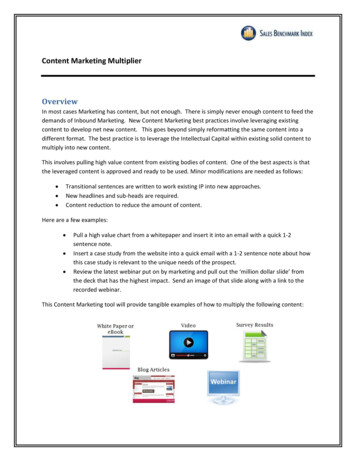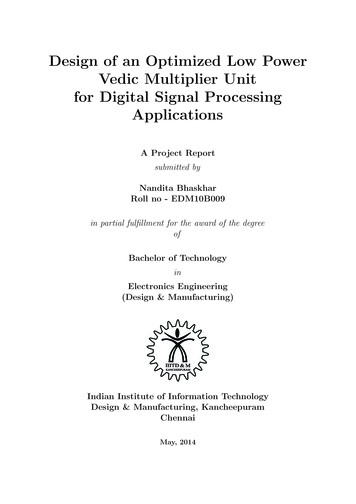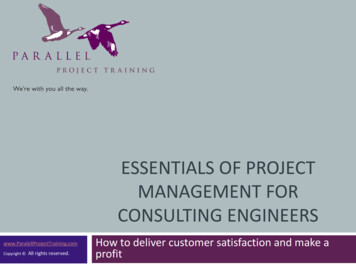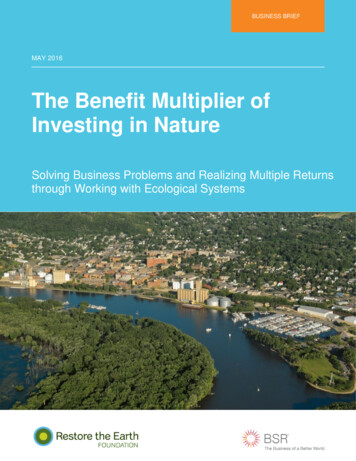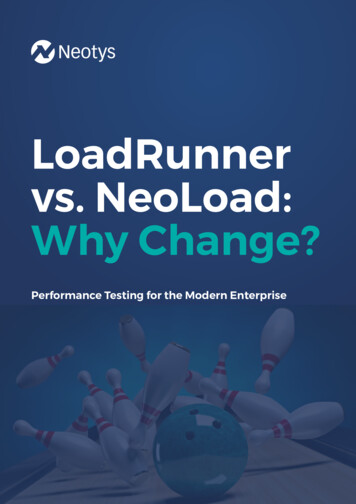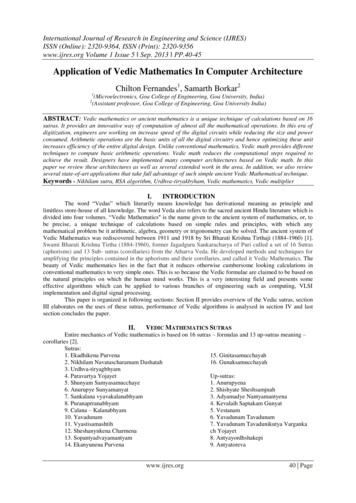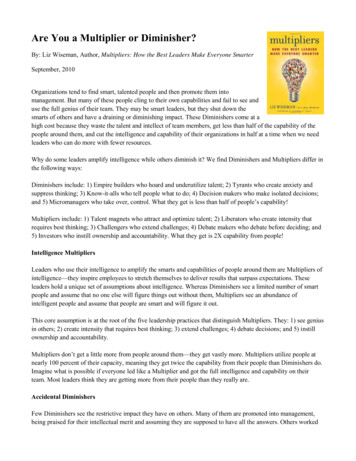
Transcription
Are You a Multiplier or Diminisher?By: Liz Wiseman, Author, Multipliers: How the Best Leaders Make Everyone SmarterSeptember, 2010Organizations tend to find smart, talented people and then promote them intomanagement. But many of these people cling to their own capabilities and fail to see anduse the full genius of their team. They may be smart leaders, but they shut down thesmarts of others and have a draining or diminishing impact. These Diminishers come at ahigh cost because they waste the talent and intellect of team members, get less than half of the capability of thepeople around them, and cut the intelligence and capability of their organizations in half at a time when we needleaders who can do more with fewer resources.Why do some leaders amplify intelligence while others diminish it? We find Diminishers and Multipliers differ inthe following ways:Diminishers include: 1) Empire builders who hoard and underutilize talent; 2) Tyrants who create anxiety andsuppress thinking; 3) Know-it-alls who tell people what to do; 4) Decision makers who make isolated decisions;and 5) Micromanagers who take over, control. What they get is less than half of people’s capability!Multipliers include: 1) Talent magnets who attract and optimize talent; 2) Liberators who create intensity thatrequires best thinking; 3) Challengers who extend challenges; 4) Debate makers who debate before deciding; and5) Investors who instill ownership and accountability. What they get is 2X capability from people!Intelligence MultipliersLeaders who use their intelligence to amplify the smarts and capabilities of people around them are Multipliers ofintelligence—they inspire employees to stretch themselves to deliver results that surpass expectations. Theseleaders hold a unique set of assumptions about intelligence. Whereas Diminishers see a limited number of smartpeople and assume that no one else will figure things out without them, Multipliers see an abundance ofintelligent people and assume that people are smart and will figure it out.This core assumption is at the root of the five leadership practices that distinguish Multipliers. They: 1) see geniusin others; 2) create intensity that requires best thinking; 3) extend challenges; 4) debate decisions; and 5) instillownership and accountability.Multipliers don’t get a little more from people around them—they get vastly more. Multipliers utilize people atnearly 100 percent of their capacity, meaning they get twice the capability from their people than Diminishers do.Imagine what is possible if everyone led like a Multiplier and got the full intelligence and capability on theirteam. Most leaders think they are getting more from their people than they really are.Accidental DiminishersFew Diminishers see the restrictive impact they have on others. Many of them are promoted into management,being praised for their intellectual merit and assuming they are supposed to have all the answers. Others worked
for Diminishers or in diminishing cultures so long that they’ve gone native. As one high-tech Director said, “Ihave the heart and mind of a Multiplier, but I’ve lost my way.”Organizations create hierarchy that is inherently diminishing and causes people to shut down and comply; thus,many well-intended leaders accidentally diminish the smarts of their people. Here are three popular types ofAccidental Diminishers: Visionaries: Visionaries are big thinkers who lay out a compelling picture of the future and evangelize it. Butthey might be providing too prescriptive a vision to their team and not leaving enough space for others to thinkthrough the challenges and build the intellectual muscle to make the vision a reality. Consider the impact of a newVP at a consumer electronics company who was hired to drive growth in an important emerging market. He laidout a bold vision for the business in his region. But instead of engaging his team’s enthusiasm, his effect was theopposite—and people became apathetic. One key member of his team put it this way, “there is such a huge gapbetween what he is telling us to do and what we actually can do, we just give up. We have no idea how we canmake his vision a reality.” Idea Guys: Idea Guys are fountains of creativity, and their minds race with non-stop ideas. They may thinkthey’re sparking innovation, but they cause whiplash as people scurry to keep up with each new idea, makingminor progress in many directions. One product executive would launch a new focus or initiative each week. Hisdirector of operations recalled, “He’d tell us on Monday, “We needed to catch up with Competitor X.” Theorganization would scurry, throw a “Hail Mary” pass and make progress for a few days, but then lose tractionwhen they were given a new goal to chase next week. Rescuers: Many well-intending managers jump in and rescue their people or a project to help the person avertfailure and get on the path of success. But when rescuing struggling people, you weaken their ability to think forthemselves and to learn how to spot problems and recover from them. Instead of creating a cycle of success, youcreate chronic dependency on the leader. When a new VP at GAP, Inc. redefined her role as a Multiplier, shestopped jumping in to trouble-shoot problems for her team, shifted the burden of thinking to them, and gave themgreater accountability.Accidental or not, you are not tapping the full brainpower of your team.Lead Like a MultiplierHow can you stop being a Diminisher and start being a Multiplier? Here are three simple but powerful startingpoints:1. Shift from answers to questions. Don’t provide all the answers—ask the right questions. Use your knowledgeof the business or a situation to ask insightful and challenging questions that cause people to stop, think, andrethink. Instead of continually selling your vision, ask the questions that get other people thinking and piecingtogether that vision for themselves.2. Dispense your ideas in small doses. If you are an idea guy who is prone to toss out more ideas than anyonecan catch or have the gift of gab, try dispensing your ideas in small, but intense doses. Introduce fewer ideas, andleave white space. Providing more distance between your ideas creates room for others to contribute; and, peoplereally listen when you say something. Imagine playing your ideas like poker chips, carefully placing each where itcreates the most value.
3. Expect complete work. People learn best when they are fully accountable and experience the consequences oftheir work. Instead of jumping in and fixing the work of others, give it back to them and let them know whatneeds to be improved or completed. Ask people to go beyond pointing out problems: Ask them to find a solution.By wrestling with it, they’ll grow their capability and operate more independently.Intelligence might be your most underutilized asset. If you’ve cut resources and have fewer people but the sameworkload, realize that the brainpower needed to solve your most pressing challenges is sitting right in front ofyou. Spot the ways you might be inadvertently diminishing others and who can become Multipliers who fullyutilize and amplify the intelligence and capability of the people around them."Reprinted by permission of Leadership Excellence. For more information about Leadership Excellence products and servicesplease visit www.leaderexcel.com."
NOVEMBER 7, 2012U.S. PUBLIC FINANCEUS Academic Medical Centers: Complex,Successful Organizations Driven by IntegratedUniversity-Hospital StrategiesSPECIAL COMMENTNew Challenges on the HorizonSummaryTable of Contents:SUMMARYGREATER INTEGRATION DRIVES AMCSUCCESS, BUT MORE RISKS AHEADDEFINING THE ACADEMIC MEDICALCENTER: BEYOND THE TEACHINGHOSPITALDISTINGUISHING CREDITCHARACTERISTICS OF AMCS: TRIPARTITEMISSION RESULTING IN REVENUEDIVERSIFICATION AND STRONGERBALANCE SHEETSBROAD RANGE OF ORGANIZATIONALMODELS AND UNIVERSITY-HOSPITALCREDIT LINKAGESAPPENDIX A: MAJOR US ACADEMICMEDICAL CENTERSMOODY’S RELATED RESEARCH12335819Analyst Contacts:BOSTON 1.212.553.1653Kimberly Tuby 1.617.371.2938Vice President – Senior Credit Officerkimberly.tuby@moodys.comSAN FRANCISCOAcademic medical centers (AMCs) are among the most complex organizations issuing debtin the US municipal market. Large organizations generating billions of dollars inconsolidated annual revenue, AMCs are often the biggest employers and drivers of economicdevelopment in their metropolitan regions. Defying easy categorization and often confusedwith smaller and more numerous teaching hospitals, AMCs are actually hybrid universityhospital organizations. They are typically centered on the nation’s leading researchuniversities which operate medical schools, often spanning different legal entities that canissue debt separately. In this publication, we define the broad characteristics of AMCs andexplore the two basic organizational models —university-owned and university-affiliated—that drive the university-hospital relationship.1Following a decade of greater integration, better competitive positioning and improvedoperating results, AMCs face heightened credit risks in coming years. Federal and some stategovernments are pressuring hospitals to become more cost effective, which is especiallychallenging for AMCs due to their high operating cost structures. The weak outlook forfunding for hospital reimbursements and research grants also indicates rising pressure onAMCs as they deal with ebbing revenue growth. 1.415.274.1708Daniel Steingart 1.949.429.5355Assistant Vice President – Analystdaniel.steingart@moodys.comNEW YORK 1.212.553.1653John C. Nelson 1.212.553.4096Managing Director – Public Financejohn.nelson@moodys.com» contacts continued on the last page1In future publications, we will publish additional research on AMC credit characteristics, including assessment of past financial metrics as well as an outlook for thisimportant subsector straddling the higher education and health care industries.
U.S. PUBLIC FINANCEGreater Integration Drives AMC Success, but More Risks AheadAMCs operate multiple lines of business based on their core functions of medical education, primaryto-quaternary patient care, and basic research. Larger ones often extend their activities to includeclinical drug trials, creation of new biomedical inventions/clinical procedures, and technology transfer,including commercialization of research discoveries.In the 1990s, US universities faced weakening performance at their hospitals and many decided to sellor spin-off their hospitals in a strategy intended to separate the perceived higher risk of the hospitalfrom the more stable university. That trend reversed over the past decade as universities and hospitalsbegan to capture greater value from closer integration.2Fueled by heightened federal research funding from 1995-2005, a sharp rise in large gifts forbiomedical research, and more professional hospital management, integrated AMCs expandedsignificantly in the past decade. Many adopted competitive strategies used by leading hospital systems,including the purchase of feeder community hospitals and tougher bargaining with insurancecompanies, allowing them to become better financial performers than in the prior decade. Some havegrown so large that they serve important roles as economic engines and large employers within theirgeographic regions.The next decade will likely be more challenging for AMCs as they will face tougher credit challenges,including:»Continued slowdown in federally sponsored research,»Reduced graduate medical education (GME) funding,»Expense reduction, especially in light of need to support research and teaching missions,»Integration of faculty physician plans and balancing different needs of community and facultyphysicians, and»Uncertain impacts of federal healthcare reform which will reward high quality performers withlow cost structures.However, these risks have not prevented the sector from growing. Often with support of state or localgovernments, new medical schools have been established and some existing medical schools havemerged with universities to expand the university’s research reputation and create a greater clinical carefootprint.22There are multiple cases of high profile legal separations of hospitals from their parent universities, later followed by re-integration, including Stanford University,University of California at San Francisco, University of Southern California, and New York University.NOVEMBER 7, 2012SPECIAL COMMENT: US ACADEMIC MEDICAL CENTERS: COMPLEX, SUCCESSFUL ORGANIZATIONSDRIVEN BY INTEGRATED UNIVERSITY-HOSPITAL STRATEGIES
U.S. PUBLIC FINANCEDefining the Academic Medical Center: Beyond the Teaching HospitalWe define an AMC as a combined university-hospital entity operating under well-defined parametersand centered on a medical school 3. Far more than just a teaching site for medical students, the AMCcarries out a full complement of clinical, research, and educational activities through an establishedpartnership between the medical school and its owned or affiliated teaching hospital(s). There aretypically very close working relationships across senior leadership teams at the medical school and thehospital and, in some cases, board composition overlap or joint governance, although this varies acrossinstitutions.The medical schools at the center of these university-hospital partnerships are housed within some ofthe highest rated research universities that have global reputations, attract top faculty and students, andoperate diversified research programs funded by grants and contracts from the public and privatesectors. These research universities have established relationships with hospitals, providingopportunities for hands-on teaching for medical students and “bench to bedside” translationalresearch. Although many hospitals have some medical education component and serve as “teachinghospitals,” most teaching hospitals are not actually part of an academic medical center. In addition totheir comprehensive tertiary and quaternary clinical care programs, AMCs provide education formedical residents and other students, and physicians at the hospital often hold faculty positions at themedical school. Most also provide significant primary and secondary patient care, especially inaffiliated or owned feeder hospitals that generate referrals for higher-end services delivered at the coreAMC hospital.In Appendix A, we provide a list of major US academic medical centers, where research funding fromthe National Institutes of Health (NIH) across the university-hospital entity exceeds 50 million. Inconjunction with this publication, this database has also been released in an Excel format.Distinguishing Credit Characteristics of AMCs: Tripartite Mission Resulting inRevenue Diversification and Stronger Balance SheetsAcademic medical centers tend to be large and complex organizations benefiting from diversifiedrevenue that contributes to relatively high debt ratings. As shown in Appendix A, the median rating isAa2 for universities and A1 for hospitals, for the rated universities and hospitals included in theappendix. In addition to net patient revenue generated at the hospital, faculty practice plans or clinics,AMCs rely on research grants and contracts, student charges, philanthropy, state support, andendowment spending to support operating activities. Graduate medical education (GME) fundingfrom the federal government helps to subsidize the costs of training residents and medical students.Research and teaching activities are typically not fully covered by grants and tuition income,respectively, and are often subsidized by surpluses generated from patient care. Depending on theoperating or affiliation agreement between a hospital and medical school, the hospital may makerecurring transfers to the university to support strategic investments, program development, andeducational activities. This is sometimes done in the form of a “Dean’s Tax.”33We identify a small number of major AMCs that are not centered on a medical school. These institutions conduct significant research and patient care and areidentified in Appendix A as “Independent Hospital and Research Organizations.”NOVEMBER 7, 2012SPECIAL COMMENT: US ACADEMIC MEDICAL CENTERS: COMPLEX, SUCCESSFUL ORGANIZATIONSDRIVEN BY INTEGRATED UNIVERSITY-HOSPITAL STRATEGIES
U.S. PUBLIC FINANCEThe patient care component of the AMC is carried out at the hospital(s), faculty practice plans, and insome cases, a network of outpatient settings. Distinguishing factors of these clinical sites may include:»High-end tertiary and quaternary procedures and a multitude of specialties, distinguishing anAMC from a community hospital focused on primary and secondary clinical care,»On average, higher case mix indices than most community hospitals,»In some cases, national and international draw of patients as a result of the AMC hospital’s clinicalexpertise and reputation, and»Location in urban settings and role as the region’s safety net hospital and trauma center, providingcare for a relatively high proportion of Medicaid and uninsured patients. As a result, clinicaloperating performance may be pressured by higher levels of uncompensated care.The financial performance of AMC hospitals has generally improved over the last decade. Many thatwere struggling now generate stable and, in some cases, above average operating margins. For example,Duke University Health System (Aa2) and New York University Hospitals Center (A3) havesignificantly improved their operating margins from modest deficits or very small surpluses in FY 2003and 2004 to bigger surpluses in FY 2010 and FY 2011. Also improving their performances over thepast decade are the hospitals of Stanford University (Aaa), the University of California (Aa1), theUniversity of Pennsylvania (Aa2) , the University of Rochester (Aa3), and Vanderbilt University (Aa2).AMC hospitals learned over the past decade to use their market strength in the provision of tertiaryand quaternary services to gain better reimbursement rates in commercial insurance contracting. Theyalso effectively adopted the strategies of successful health systems and community hospitals: increasingproductivity and trimming expenses, acquiring smaller hospitals, establishing outpatient centers toimprove patient access, and aligning with community physicians in order to gain scale and generatereferrals.Virtually all highly rated major universities have robust fundraising programs that generate tens orhundreds of millions of gift revenue annually. In contrast, philanthropy for most stand-alone hospitalsand hospital systems tends to be much more modest. Donors are especially attracted to supportingresearch at an AMC’s medical school, making fundraising a major credit strength of many academicmedical centers that most of their competitors lack. The few standalone non-university medicalcenters are also successful in attracting private gifts, and a few other hospital sub-sectors, includingchildren’s hospitals and specialized hospitals such as cancer research institutions, are also adept atattracting significant donor support. In some cases, universities and their owned or affiliated hospitalshave joined forces to launch coordinated capital campaigns. The most successful AMC fundraisers arerecipients of sizeable gifts and have strong balance sheets, including restricted funds to support futureresearch, educational activities and capital projects.4NOVEMBER 7, 2012SPECIAL COMMENT: US ACADEMIC MEDICAL CENTERS: COMPLEX, SUCCESSFUL ORGANIZATIONSDRIVEN BY INTEGRATED UNIVERSITY-HOSPITAL STRATEGIES
U.S. PUBLIC FINANCEBroad Range of Organizational Models and University-Hospital Credit LinkagesThere is a broad spectrum of AMC models (Exhibit 1), ranging from a university’s full ownership of ahospital to legally independent operations and arm’s length transactions. Some universities own theirhospitals or serve as the sole corporate member of the hospital. Others are legally distinct entities withvery tight affiliations and in some cases, overlapping governance and management. Some of the largestAMCs are comprised of a medical school and hospital(s) that are legally independent organizations,but have tight working relationships and are highly dependent on each other for research, academic,and clinical cross-collaboration. Two prominent examples are Washington University in St. Louis(Aaa, stable) and BJC Healthcare (Aa2, stable) as well as Harvard University (Aaa, stable) and its manyBoston-area teaching hospitals. Neither of these universities directly owns a hospital, but each is partof a very large, prominent academic medical center, with high levels of research and clinical activity.The varied arrangements and uniqueness of these relationships warrant analyzing the credit impact ofthese partnerships on a case-by-case basis.Over time, university-hospital relationships and operating models change according to the perceivedrisks and benefits accruing to both organizations. Organizations may grow closer or potentiallydistance themselves for a variety of reasons, including financial motives, industry trends, orrelationship dynamics of senior leadership. During the 1990s, there was a pronounced trend ofuniversities divesting or distancing themselves from their financially struggling hospitals. Examplesincluded Georgetown University (A3, positive), George Washington University (A1,stable), TulaneUniversity (A2, stable), and University of Minnesota (Aa1, stable). However, over the last decade,management and governance teams of universities and their affiliated or owned hospitals have largelygrown closer with greater coordination regarding competitive strategy, research, financial and capitalplanning, and fundraising. There are several examples of jointly coordinated comprehensive capitalcampaigns.5NOVEMBER 7, 2012SPECIAL COMMENT: US ACADEMIC MEDICAL CENTERS: COMPLEX, SUCCESSFUL ORGANIZATIONSDRIVEN BY INTEGRATED UNIVERSITY-HOSPITAL STRATEGIES
U.S. PUBLIC FINANCEEXHIBIT 1Two Basic Organizational Models for Academic Medical CentersOwnershipExamples: Emory University, Vanderbilt University, University of Miami, University of Rochester,University of Missouri, University of Michigan, Duke University, Stanford University.»This may include situations where both the university and hospital are distinct 501c3 not forprofit organizations, but the university is the sole corporate member of the hospital. In othercases, the hospital may be an operating division of the university.»University and hospital campuses are likely physically intertwined or within close proximity.»Audited financial statements present a consolidated view of university and hospital (hospitalmay or may not produce separate audited financial information).»Overlap in senior leadership and board composition between university and hospital.»History of financial support, including recurring cash transfers from the hospital to university.»In some cases, specific examples of financial or other support, from university to hospital, suchas fundraising, debt guarantees, or provision of liquidity.»Hospital operating and capital budgets subject to university board approval.»Independent or consolidated revenue stream as legal security for bonds (for example, hospitalrevenues support hospital debt, and university resources support university debt).AffiliationExamples: Columbia University, Cornell University, Harvard University, Washington University inSt. Louis.»Legally separate university and hospital that operate independently; no “ownership”.»Separately secured debt.»Separate audited financial statements.»Typically no history of extraordinary financial support above and beyond payment for servicesprovided and those payments outlined in affiliation agreement.»Hospital budgets and capital projects not likely subject to university oversight or approval.»University and hospital campuses may be physically intertwined or completely separate.As we highlight in our 2011 updated rating methodology for US not-for-profit private and publichigher education, health care exposure is an important credit factor and incorporated into universitybond ratings. Depending on the organizational structure of the academic medical center, the patientcare revenue may or may not directly flow through the university’s audited financial statements. In auniversity’s audit, patient care revenue can represent a variety of revenue streams, including a hospital,faculty practice plan, patient care at clinics, or transfers from the hospital to the university. Exhibit 2highlights that over 60% of universities with medical schools have patient care-related operatingrevenue. In order to incorporate healthcare exposure into a university’s bond rating, we assess thefinancial performance and market positions of the hospital(s) and faculty practice plans.6NOVEMBER 7, 2012SPECIAL COMMENT: US ACADEMIC MEDICAL CENTERS: COMPLEX, SUCCESSFUL ORGANIZATIONSDRIVEN BY INTEGRATED UNIVERSITY-HOSPITAL STRATEGIES
U.S. PUBLIC FINANCEEXHIBIT 2Patient care revenue is an important revenue stream for most universities with medical schools(patient care as a % of total operating revenue, FY 2011)# of universities with medical schools5040302010Above 30%Between 15% and 30%Between 0% and 15%No Patient Care Revenuepatient care as a % of total operating revenue, FY 2011Source: Moody's MFRA, AAMCA hospital’s relationship with a university may impact its standalone bond rating. Direct ownership bya higher rated university may positively influence a hospital’s bond rating. Key credit considerationsinclude the historical relationship between the university and hospital, the flow of funds between thetwo entities, the governance and management overlap, fundraising support from the university, andany incentives to help each other if a period of fiscal distress is encountered.7NOVEMBER 7, 2012SPECIAL COMMENT: US ACADEMIC MEDICAL CENTERS: COMPLEX, SUCCESSFUL ORGANIZATIONSDRIVEN BY INTEGRATED UNIVERSITY-HOSPITAL STRATEGIES
U.S. PUBLIC FINANCEJANUARY 16, 2013US Higher Education Outlook Negative in 2013INDUSTRY OUTLOOKRevenue Pressure on All Fronts Intensifies Need to Grapple with Traditional Cost StructureTable of Contents:SUMMARYFACTOR #1: PRICE SENSITIVITYCONTINUES TO SUPPRESS NET TUITIONREVENUE GROWTHFACTOR 2: ALL NON-TUITION REVENUESOURCES ARE ALSO STRAINED;DIVERSITY NO LONGER OFFERS A SAFEHAVENFACTOR 3: RISING STUDENT LOANBURDEN AND DEFAULTS TAINT THEPERCEPTION OF VALUE OF A COLLEGEDEGREEFACTOR 4: INCREASED PUBLICSCRUTINY DRIVES ESCALATED RISKOF MORE REGULATION ANDACCREDITATION SANCTIONSFACTOR 5: PROSPECTS FOR LONG-TERMSUSTAINABILITY DEPEND UPONSTRONG LEADERSHIP THROUGH BETTERGOVERNANCE AND MANAGEMENTOUTLOOK FOR RELATED SECTORSMOODY’S RELATED RESEARCH1371113151922Analyst Contacts:NEW YORK 1.212.553.1653Eva Bogaty 1.212.553.7124Assistant Vice President - Analysteva.bogaty@moodys.comEdith Behr 1.212.553.0566Vice President - Senior Credit Officeredith.behr@moodys.comKaren Kedem 1.212.553.3614Vice President - Senior Analystkaren.kedem@moodys.comJohn C. Nelson 1.212.553.4096Managing Director - Public Financejohn.nelson@moodys.comThis outlook expresses our expectations for the fundamental credit conditions in the sectorover the next 12 to 18 months. It does not speak to expectations for individual ratingchanges and is not a prediction of the expected balance of rating changes during this timeframe.SummaryFor 2013, Moody’s revises its outlook for the entire US higher education sector to negative,marking a shift to negative from stable for even the sector’s market leading diversifiedcolleges and universities. The outlook for the remaining majority of the sector remainsnegative, as it has been since 2009. The new sector-wide negative outlook reflects mountingpressure on all key university revenue sources, requiring bolder actions by university leadersto reduce costs and increase operating efficiency. As the economic growth languishes belowprevious benchmarks and the federal government seeks to reduce spending in key areas, evenmarket leading universities with diversified revenues are facing diminished prospects forrevenue growth. Universities have been restraining costs in response to the weak economicconditions since the 2008-09 financial crisis, but they have only recently begun examiningthe cost structure of their traditional business model.Macroeconomic conditions and anticipated federal budget reductions have weakened orcreated considerable uncertainty around the prospect for growth of household income andwealth, philanthropic support, investment returns, state appropriations, and federal funding.In addition to recent tax code changes, the resolution of the federal fiscal deficit will likelyinvolve flat to diminished research funding, cuts to Medicare and Medicaid as well aspossible changes to federal student aid programs such as Pell Grants – all of which wouldimpact important revenue streams for higher education.The underlying value proposition of higher education persists, lending inherent creditstrength and support for ongoing demand for the sector’s services. However, the sector willneed to adjust to the prospect of prolonged muted revenue growth. Strong governance andmanagement leadership will be needed by most universities as they navigate through thisperiod of intensified change and challenge.
U.S. PUBLIC FINANCEWe continue to watch the impact of several emerging trends in higher education which have alreadyshown some destabilizing effects on colleges and universities, including the growth of on-line learningtechnology initiatives such as Massive Online Open Courses (MOOC); rising student debt burdensand defaults; greater government focus on cost and value of college education degrees and increasedactivity by accrediting agencies.Critical factors contributing to the negative outlook:1. Price sensitivity continues to suppress net tuition revenue growth
MODELS AND UNIVERSITY-HOSPITAL CREDIT LINKAGES 5 APPENDIX A: MAJOR US ACADEMIC MEDICAL CENTERS 8 MOODY'S RELATED RESE ARCH 19 Analyst Contacts: BOSTON 1.212.553.1653 Kimberly Tuby 1.617.371.2938 Vice President - Senior Credit Officer kimberly.tuby@moodys.com SAN FRANCISCO 1.415.274.1708 Daniel Steingart 1.949.429.5355



